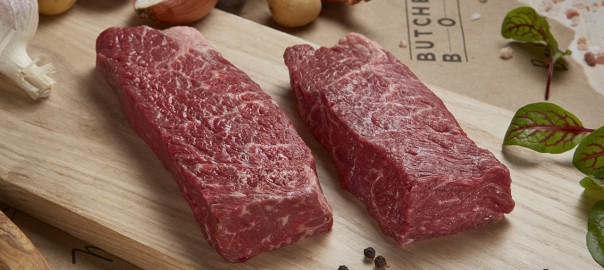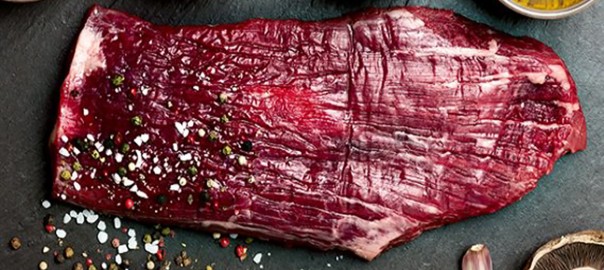While discoveries in centuries-old industries are exceedingly rare, they do still occur from time to time.
Witness the Denver steak, a uniquely American, and rather “new” cut of meat that, if you are lucky, you can find on the menu at some of the best purveyors of meat across the country. (The Denver steak is also a part of this month’s ButcherBox for some subscribers.)
While the profession of “butcher” has been around likely as long as cattle have been domesticated — and the oldest butcher guild in England was founded in the tenth century — the Denver cut is less than a decade old.
So first, what exactly is a Denver steak?
The cut comes from the chuck roll, which is mostly muscular meat from the area that starts under the shoulder blade and continues to the ribs and backbone. Some common steaks that derive from this area include the ribeye and Delmonico steaks. More specifically, the Denver steak comes from the serratis ventralis section of the chuck underblade. Most of the meat in this area is tough and tends to be used for ground beef and stew meat. If it is cooked for other purposes, it often needs to be braised or roasted over long periods of time.
But the Denver steak is an exception to the tough beef from this part of a cow.
Getting at a Denver steak out of the chuck roll is a bit of an onerous process. It usually comes from a section that accounts for only eight total pounds of an average 25-pound chuck roll. The cut is a part of the muscle that is more flavorful, due to marbling, and more tender than the surrounding meat. This section of the shoulder underblade gets a lot of use, but the particular area that derives the Denver steak is one often used less and therefore has more fat, i.e., marbling. The challenge of making this often tear-shaped cut comes from separating the tough connective muscle tissue surrounding it.
It is a very rare — as in challenging to find — cut. In fact, before 2009, you couldn’t find a Denver steak at all. It didn’t exist.
(Note: The history on this steak is a bit confusing, as similar steaks appear in other cultures across the world. Their origin, too, is not always clear. For instance, the zabuton is an extremely rare cut of Wagyu steak found in Japan. The name, which in Japanese means “flat cushion,” refers to the shape it is often presented in. This cut is often sliced extremely thin and cooked for a very short period of time — like eight seconds. Similar cuts from the same region of a cow can be found throughout the world, yet, as far as I’ve found, few are promoted as a steak meant to be thrown on the grill and cooked. The key modifier in the previous sentence being “promoted,” as you will see below.)
The Denver steak as we know it comes out of a project funded by the Cattleman’s Beef Board, the Beef Checkoff Program, a project whose goal is to identify and promote new and potentially more affordable cuts of meat. The Denver steak is the result of a research project from the 1990’s by meat-science professors at the University of Florida and the University of Nebraska.
The moniker “Denver steak” has no historical significance; it is not as if the cut is more popular in the Rocky Mountain foothills. It is actually the marketing brainchild of Beef Checkoff Program and was “unveiled” with the cut in 2009.
So, in more ways than one, the Denver steak, both an innovation and a bit of a marketing ploy, is a most American creation.
One last thing to know about the Denver steak: Among the thousands of cuts identified during the research project that led to the discovery of the cut, the Denver steak is the fourth most tender muscle section of a heifer, steer, or cow.
You will undoubtedly discover this once you take your first bite.
According to most — but not all — chefs, the best way to cook a Denver steak is to do so rather quickly on a very hot grill. The key to a great Denver steak experience, however, is how you slice this particular cut.
As we’ve pointed out before, how you cut your steak can have a tremendous impact on taste and tenderness; cutting the wrong way and you will make a potentially delectable steak tough and less flavorful. This is especially true for a Denver steak which could be considered a cousin to other, better-known steaks to come out of the Beef Checkoff program such as the flat iron steak.
Like many other muscular cuts, the Denver steak should be cut against the grain for maximum taste and tenderness. Also, be careful not to overcook, something that is especially true with grass-fed steaks.
Now you know more about the cut, get out there an throw one on the grill and enjoy so good old-fashioned American ingenuity.




